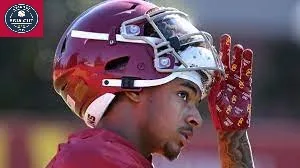College football, a sport cherished for its traditions, rivalries, and passionate fan base, underwent a seismic shift in the 1980s, setting it on a course of transformation that continues to impact the game today. At the center of this transformation stands Andrew Coats, a lawyer whose successful argument before the U.S. Supreme Court in 1984 forever changed the landscape of college football.
The Landmark Case: NCAA v. Board of Regents of the University of Oklahoma
The case of NCAA v. Board of Regents of the University of Oklahoma marked a turning point in the relationship between college athletics and broadcasting rights. Coats, the attorney representing the University of Oklahoma, found himself in a position to challenge the NCAA’s authority over the trade rights of schools and conferences.

A Shift in Paradigm: From Restrained Trade Rights to Football Revenue Maximization
Coats’ victory before the Supreme Court paved the way for universities to maximize football revenue through broadcasting deals. The court’s ruling in favor of Coats’ clients shattered the previous limitations on the broadcasting of college football games, leading to a television-driven money rush that forever altered the financial landscape of the sport.
The Fallout: College Football’s Unpredictable Transformation
The aftermath of the Supreme Court decision was profound and far-reaching. Once-stable conferences were no longer bound by geographic considerations, and universities began shifting affiliations in search of more lucrative broadcasting contracts. Traditional rivalries faced the threat of dissolution, and the focus on student-athlete well-being took a backseat to financial gains.
The Unforeseen Consequences: Struggles of Student-Athletes in a Shifting Landscape
As conferences realigned and teams embarked on cross-country travels for games, the burden fell heavily on student-athletes, particularly those in non-revenue and Olympic sports. Athletes like Paige Sinicki, a softball player at Oregon, found themselves facing unexpected challenges and far-flung competition that deviated from their initial expectations.
The Regret: Andrew Coats’ Candid Reflections
Despite his success in the courtroom, Andrew Coats looks back on his role in the transformation of college football with a sense of regret. Coats acknowledges that the sweeping changes he helped bring about have led to unintended consequences, impacting not only the sport itself but also the lives of student-athletes.
From Local to National: The Revolution of College Football Broadcasting
The shift in broadcasting rights dramatically expanded the availability of college football games on television. What was once a limited number of games broadcast nationally turned into a continuous stream of matchups accessible to fans across the country.
Conference Realignment: A Seismic Shift in the College Football Landscape
The realignment of conferences following Coats’ victory ushered in a new era of uncertainty and change. Schools once bound by regional affiliations began joining conferences scattered across the nation, erasing the traditional boundaries that had defined college football rivalries.
A Jenga Game of Conferences: The USC and UCLA Defections
The decisions of schools like USC and UCLA to join conferences far from their geographic locations exemplify the drastic nature of the realignment. Such moves have repercussions not only on historic rivalries but also on the identities of conferences that have stood for generations.

A New Reality: The Reshaping of Historic Rivalries and Conference Identities
As the landscape of college football shifts, historic rivalries face the threat of dissolution, and conferences grapple with their changing identities. Schools and fans alike must adjust to the new reality, where traditional matchups are no longer guaranteed.
The Unpredicted Evolution: College Football’s Ever-Changing Nature
While Andrew Coats’ victory played a pivotal role in shaping the current state of college football, it’s important to recognize that change was inevitable. College football has always evolved, reflecting societal shifts, technological advancements, and shifting priorities.
A Predicted Regret: Justice Byron White’s Warning
Justice Byron “Whizzer” White’s warning to Andrew Coats about potential regret following his victory in the Supreme Court case proved prescient. While Coats’ impact on college football is undeniable, the transformation was a result of various forces, and others could have similarly influenced the sport’s trajectory.
Conclusion: Balancing Change and Tradition in College Football
The story of Andrew Coats and the Supreme Court decision serves as a reminder that change is a constant in college football. As the sport continues to evolve, it’s crucial to find a balance between embracing innovation and preserving the cherished traditions that make college football a beloved American pastime.
FAQs About the Supreme Court Decision and College Football’s Transformation
- What was the NCAA v. Board of Regents case about?
- How did Andrew Coats’ victory impact college football?
- What were the unintended consequences of the Supreme Court decision?
- How did the shift in broadcasting rights affect college football?
- What challenges did student-athletes face in the changing landscape?




